Clipart tagged: ‘non-migratory birds’
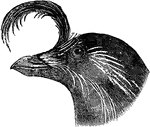
Whiskered Auk
"Simorhynchus pygmaeus. Whiskered Auk. Red-nosed Auk. Bill (dry) orange-red, more salmon color or yellow…

Young Whiskered Auk
"Simorhynchus pygmaeus. Whiskered Auk. Red-nosed Auk. Bill very small and weak, much compressed. No…
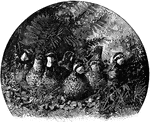
Bob-white Family
"Ortyx virginiana. Virginia Partridge or "Quail". Bobwhite. Male: Forehead, superciliary line, and throat,…

Male and Female Bob-whites
"Ortyx virginiana. Virginia Partridge or "Quail". Bobwhite. Male: Forehead, superciliary line, and throat,…

Black-capped Chickadee
"Crown and nape, with chin and throat, black, separated by white sides of the head. Upper parts brownish-ash,…
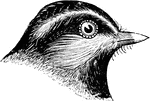
Mountain Chickadee
"Upper part ashy-gray, with scarcely a shade, and only on the rump, under parts similarly grayish-white,…
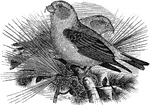
American Red Crossbill
"Loxai curvirostra. American Red Crossbill. Red; wings and tail blackish, without white markings. Middle…

White-winged Crossbill
"Loxia leucoptera. White-winged Crossbill. Rosy-red, sometimes carmined or even crimsoned, obscured…
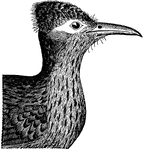
Ground Cuckoo Head
"Geococcyx californianus. Ground Cuckoo. Chaparral Cock. Road Runner. Snake Killer. Paisano. Most of…
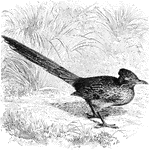
Ground Cuckoo
"Geococcyx californianus. Ground Cuckoo. Chaparral Cock. Road Runner. Snake Killer. Paisano. Most of…

Swainson's Rosy Finch
"Leucosticte tephrocotis. Swainson's Rosy Finch. Gray-crowned Rosy Finch. Sexes similar. Adult in breeding…
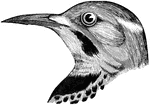
Flicker
"Colaptes auratus. Golden-winged Woodpecker. Pigeon Woodpecker. Flicker. Yucker. High-holder. Back and…

Meadow Lark Foot and Bill
"Sturnella magna. Field Lark. Old-field Lark. Meadow Lark. The colors, as above described, rich and…

Black-capped Gnat-catcher
"- a, head of a (Polioptila nigriceps) Black-capped Gnat-catcher. b, head of a(Polioptila caerulea)…

Ruffed Grouse Head
"Bonasa umbella. Ruffed Grouse. "Partridge;" "Pheasant;" Above, variegate reddish- or grayish-brown,…

Canada Grouse
"Canace canadensis. Canada Grouse. Spotted Grouse. Spruce Grouse. Spruce "Partridge." Adult: Head smooth,…

Ruffed Grouse
"Bonasa umbella. Ruffed Grouse. "Partridge;" "Pheasant;" Above, variegate reddish- or grayish-brown,…

Sharp-tailed Grouse
"Pediaecetes phasianellus Columbianus. Common Sharp-tailed Grouse. Upper parts closely and pretty evenly…

Black Guillemot Bill
"Uria grylle. Black Guillemots. Bill much shorter than head, about equal to tarsus, straight, rather…
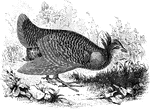
Prairie Hen
"Cupidonia cupido. Pinnated Grouse. Prairie Hen. Above, variegated with black, brown, tawny, or ochrey,…
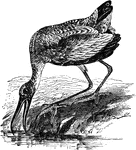
Wood Ibis
"Tantalops loculator. American Wood Stork. Wood Ibis. Colorado Turkey. Plumage white, the wing-quills,…

magpie
"Pica. rustica hudsonica. Lustrous black, with green, purple, violet, and even golden iridescence, especially…

American Nutcracker
"Picicorvus. American Nutcracker. General characteristics of the European Nucifraga. Bill slenderer,…
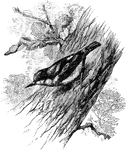
Nuthatch
"The colours in Sitta caesia, (Nuthatch) which ranges over nearly all the Palaearctic and Indian Regions,…

Barred Owl
"Strix nebulosa. Barred Owl. Hoot Owl. American Wood Owl. Toes fully feathered, nearly or quite to the…

Burrowing Owl
"Speotyto cunicularia hypogae'a. Burrowing Owl. Adult: Above, dull grayish-brown, profusely spotted…
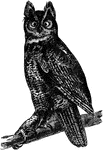
Great Horned Owl
"Bubo virginianus. Great Horned Owl. Hoot Owl. Cat Owl. Distinguished by its large size and conspicuous…
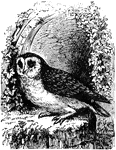
Small Barn Owls
"Aluco flammeus pratincola. Barn Owl. above, including upper surfaces of wings and tail, tawny, fulvous,…
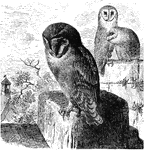
Barn Owls
"Aluco flammeus pratincola. Barn Owl. above, including upper surfaces of wings and tail, tawny, fulvous,…
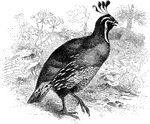
Californian Partridge
"Lophortyx californica. Californian Partridge. Valley Quail. Male: With a small white line from bill…

European Partridge
"Coturnix. Bill smaller and much slenderer than that of any of the foregoing genera of Odontophorinae;…
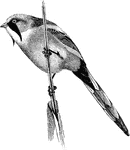
Reed Pheasant
"Panurus biarmicus, the "Bearded Tit" or "Reed-Pheasant" plumage is orange-brown above, with grey crown…
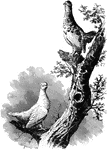
White-tailed Ptarmigan
"Lagopus leucurus. White-tailed Ptarmigan. Rocky Mountain Snow Grouse. Male and Female in winter: Entirely…
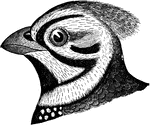
Massena Quail
"Cyrtonyx massena. Massena Partridge. Male: Upper parts intimately waved with black and reddish-brown…

Mountain Quail
"Orortyx picta. Plumed Partridge. Mountain Quail. Back, wings and tail olive-brown, the inner secondaries…

Clapper Rail
"Rallus longirostris crepitans. Clapper Rail. Salt-water Marsh-hen. Mud-hen. Above, variegated with…
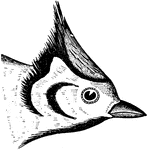
Bridled Titmouse
"Upper parts olivaceous-ash, wings and tail darker, edged with the color of the back, or even a brighter…
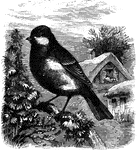
European Greater Titmouse
"Head not crested. Wings and tail rounded, of approximately equal lengths, and about as long as the…

Great Titmouse
"Parus major, the Great Titmouse, are olive, brown, or grey, varied with black, white, chestnut, or…
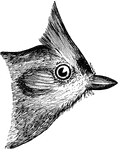
Tufted Titmouse
"Entire upper parts ashy, the back usually with a slight olivaceous shade, the wings and tail rather…

Willet Head
"Symphemia semipalmata. Semipalmated Tattler. Willet. Adult in summer: Upper parts ashy, confoundedly…
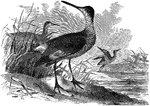
Willets
"Symphemia semipalmata. Semipalmated Tattler. Willet. Adult in summer: Upper parts ashy, confoundedly…

Downy Woodpecker
"Picus pubescens. Downy Woodpecker. Usually 6-7 long; outer tail-feathers barred with black and white.…
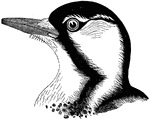
Red-cockaded Woodpecker
"Picus borealis. Red-Cockaded Woodpecker. Body spotted and crosswise banded, but not streaked. Head…
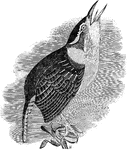
Carolina Wren
"Carolina Wren. Upper parts uniform reddish-brown, brightest on the rump, where are concealed whitish…